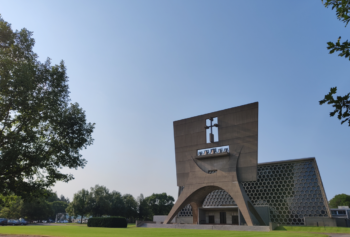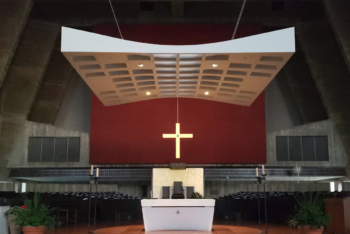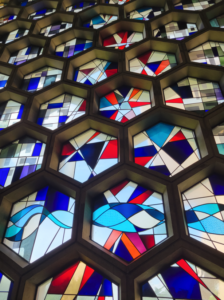 By Nicholas Tangen
By Nicholas Tangen
July 11 is the feast day of Saint Benedict of Nursia, the father of western monasticism and the writer of the Rule of St. Benedict (RB), a text that has served as a guide and ground for monastic communities over the centuries. Not many Lutherans pay attention to Benedict’s feast day and there is still enough anti-monastic juice in the Lutheran tradition that I suppose this makes sense. But as a Benedictine Oblate and a Lutheran, I have found incredible wisdom and practice among monastic communities, and I was grateful to gather with other Oblates last weekend for a retreat at St. John’s Abbey.
Okay, so first, what is an Oblate? My friends jokingly call it a monk with benefits, or cosplay for the monastically inclined. But in reality, it is someone who has vowed to live their life guided by the Rule of St Benedict while living outside the monastery – something like a lay monk.
“The experience of morning prayer, the intentional practice of offering God the first fruits of our day through the psalmody and silent reflection, captured my heart.”
Benedictine Oblates come from many traditions and backgrounds, Catholic and Protestant, lay and ordained. But what unites them are vows of humility, stability, and conversion of heart.
I first learned about Benedictine spirituality from a Spiritual Director who noticed my desire for a whole-life-encompassing faith practice and thought the monastery may have something to teach me. I came to the Lutheran church in my 20s and was transformed by the promise of God’s grace and liberation. The theology of the cross, the commitment to God’s action and grace, and the deep rootedness in Scripture took hold of me and assured me I was indeed a Lutheran.
But while the Lutheran church’s theology captured my attention and devotion, I struggled to find guidance in my church for how my life would be lived differently day to day in light of God’s grace. So, when my Spiritual Director told me about the Benedictines and the Rule that guided their life in community, I was intrigued.
 WHEN I WALKED INTO the St John’s Abbey Church on my first visit, I was immediately enthralled by the slow and steady reading of Psalms – the monastic community dressed in black cassocks praying together as one voice, one community. Early morning light poured in through hundreds of brightly colored stained-glass windows, and the rhythm of prayer and silence, prayer and silence, filled the space with wakefulness and attention. The experience of morning prayer, the intentional practice of offering God the first fruits of our day through the psalmody and silent reflection, captured my heart and let me know that I had found a community to learn alongside.
WHEN I WALKED INTO the St John’s Abbey Church on my first visit, I was immediately enthralled by the slow and steady reading of Psalms – the monastic community dressed in black cassocks praying together as one voice, one community. Early morning light poured in through hundreds of brightly colored stained-glass windows, and the rhythm of prayer and silence, prayer and silence, filled the space with wakefulness and attention. The experience of morning prayer, the intentional practice of offering God the first fruits of our day through the psalmody and silent reflection, captured my heart and let me know that I had found a community to learn alongside.
Prayer frames and animates the daily life of monastics. It’s the very breath of the Benedictine community, and that practice is one embraced not only by professed monks but by Oblates and other lay people connected to the monastery community.
This regular and daily prayer reveals that God is present in every moment, in every part of our lives, and in the lives of our community members. It attunes our attention and prepares our faculties to notice and celebrate the activity of God in our homes, our churches, and our neighborhoods.
When I first attended a Lutheran church, I was afraid to admit that I didn’t know how to pray because it seemed so private, so individualized, and so undervalued. As an adult, I could find all kinds of opportunities to learn and discuss history, theology, and social issues but struggled to find anyone who would teach me how to pray or model a life of prayer. The Benedictines taught me to pray, and more than that, showed me that Christian community is sustained by shared and individual daily prayer.
Through the Benedictine community I’ve discovered and sustained a practice of the Liturgy of the Hours, that regular time set aside in the morning, at midday, and evening to pray, praise, and reflect on God’s activity in my life. It has transformed the way I move through my daily work, recreation, and relationships. It has grounded me in the presence of God in and through every moment of my life and the life of the community I belong to.
“The Benedictines taught me to pray, and more than that, showed me that Christian community is sustained by shared and individual daily prayer.”
And my connection to the Benedictine tradition has reminded me that there is such beauty in the diversity of Christian practice. As Paul says in 1 Corinthians, “… there are varieties of gifts but the same Spirit, and there are varieties of services but the same Lord, and there are varieties of activities, but it is the same God who activates all of them in everyone” (1 Corinthians 12:4-6 NRSV).
What are the practices and traditions that have animated your own relationship with God and community? What has prayer looked like in your own life and practice? How do you attune your attention to God’s presence in your work, recreation, and relationships?
Thanks be to God for this beautiful variety and the myriad practices and communities that contribute to Body of Christ here and now. And thanks to St. Benedict whose Rule continues to offer wisdom and guidance to those yearning for life and seeking good days (RB Prologue v1). Amen.
